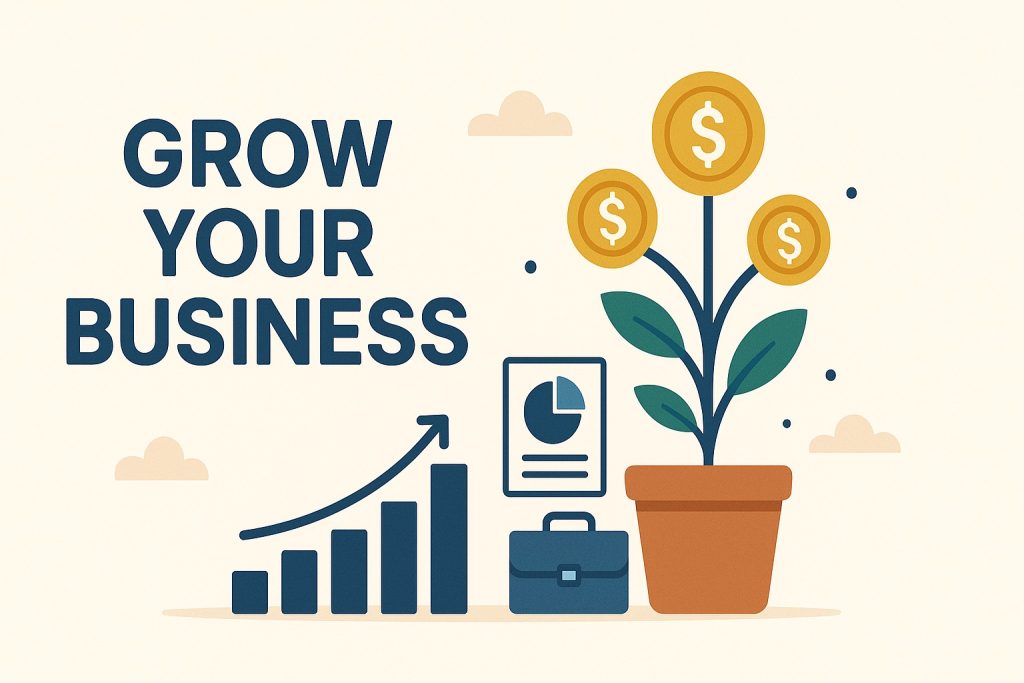Want to know the secret to business growth?
It’s not one big, magical trick. It’s a series of smart, consistent actions. Too many entrepreneurs get stuck chasing the latest shiny object, hoping for an overnight explosion in revenue. It rarely happens that way.
Real, sustainable growth comes from a solid strategy. It’s about building a strong foundation and then methodically adding layers that attract new customers, delight existing ones, and optimize your operations. Forget the get-rich-quick schemes.
I’m going to break down ten proven strategies you can start implementing today to put your business on the fast track.

From mastering digital marketing to creating an army of loyal fans, these are the tactics that separate the businesses that thrive from those that merely survive. Let’s dive in.
1. Deeply Understand Your Customer with Buyer Personas
You can’t grow if you don’t know who you’re selling to. “Everyone” is not a target audience. The first, most crucial step to growth is creating detailed buyer personas. These aren’t just simple demographic profiles; they are semi-fictional representations of your ideal customers based on market research and real data.
Why Do Personas Matter?
Without a clear picture of your customer, your marketing messages become generic and ineffective. You waste money targeting the wrong people on the wrong platforms. A well-defined persona tells you:
- What their pain points are: What problems are they trying to solve that your product or service addresses?
- Where they hang out online: Are they on LinkedIn, Instagram, TikTok, or specific industry forums?
- What their goals are: What are they trying to achieve, both personally and professionally?
- What influences their decisions: Do they read reviews, trust influencers, or rely on data-driven case studies?
How to Create a Buyer Persona
Start by interviewing your best current customers. Ask them about their challenges, how they found you, and what they love about your solution. Combine this qualitative data with quantitative data from tools like Google Analytics. Look for common patterns in age, location, behavior, and acquisition channels.

Give your persona a name, like “Marketing Manager Mary” or “Startup Steve.” Document their goals, challenges, and a “day in the life” scenario. Every marketing decision you make, from a blog post topic to a social media ad, should be aimed at helping this specific person.
2. Double Down on Content Marketing
Content marketing is not just blogging. It’s the art of creating and distributing valuable, relevant, and consistent content to attract and retain a clearly defined audience. When done right, it drives profitable customer action.
Think of it this way: traditional marketing interrupts, while content marketing attracts.
Creating a Content Machine
Your content strategy should be built around your buyer personas’ pain points. What questions are they typing into Google? Your job is to answer them better than anyone else.
Key Content Formats:
- Blog Posts: The backbone of most content strategies. Focus on “how-to” guides, listicles, case studies, and thought leadership articles. Optimize every post for search engines (SEO) to attract organic traffic.
- Video: Video is exploding. Create product demos, customer testimonials, tutorials, and behind-the-scenes content for platforms like YouTube and social media.
- Podcasts: A great way to build a connection with an audience during their commute or workout. Interview industry experts or share your own insights.
- Lead Magnets: Offer valuable resources like ebooks, checklists, or whitepapers in exchange for an email address. This is how you turn visitors into leads.
The goal is to become the go-to resource in your industry. When people have a question, they should think of you first. This builds trust and positions you as the obvious choice when they’re ready to buy.
3. Master the Art of Search Engine Optimization (SEO)
Having amazing content is useless if no one can find it. That’s where SEO comes in. SEO is the process of optimizing your website to rank higher in search engine results pages (SERPs) for specific keywords related to your business.
Think about it: billions of searches happen on Google every single day. Ranking on the first page for your target keywords can bring a constant stream of highly qualified, free traffic to your website.
SEO Fundamentals for Growth
- Keyword Research: Use tools like Ahrefs, SEMrush, or even Google’s Keyword Planner to find the terms your buyer personas are searching for. Target a mix of high-volume “head” terms and more specific “long-tail” keywords.
- On-Page SEO: This involves optimizing individual web pages. Make sure your target keyword is in your page title, meta description, H1 tag, and naturally within the body content. Ensure your site loads quickly and is mobile-friendly.
- Technical SEO: This is the behind-the-scenes stuff that helps search engines crawl and index your site efficiently. It includes things like creating an XML sitemap, using a logical site structure, and fixing broken links.
- Link Building: Earning backlinks from other reputable websites is a massive ranking factor. It’s like a vote of confidence for your site. You can earn links by creating amazing content that people want to share, guest posting on other blogs, and conducting digital PR outreach.
SEO is a long-term game, but the payoff is enormous. It’s an investment that builds an asset for your business.
4. Build a Social Media Community, Not Just a Following
Many businesses use social media as a one-way broadcast channel to push their products. That’s a mistake. The real power of social media lies in building a community.
A community is a group of engaged followers who trust your brand, interact with your content, and advocate for you. They feel a sense of belonging.
Strategies for Community Building
- Choose the Right Platforms: Don’t try to be everywhere. Focus on the 1-2 platforms where your buyer personas are most active. A B2B software company will likely find more success on LinkedIn than on Pinterest.
- Engage, Don’t Just Post: Don’t post and ghost. Respond to every comment and direct message. Ask questions in your captions to spark conversations. Go live to interact with your audience in real time.
- Share User-Generated Content (UGC): Encourage your customers to share photos or stories featuring your product. Reposting this content is powerful social proof and makes your community feel valued.
- Provide Exclusive Value: Use your social channels to offer exclusive content, early access to products, or special discounts for your followers. This gives them a reason to stick around.
A loyal community will not only buy from you repeatedly but also become your most powerful marketing channel through word-of-mouth recommendations.
5. Focus Relentlessly on Customer Retention
It’s far cheaper to keep an existing customer than to acquire a new one. Studies show that increasing customer retention rates by just 5% can increase profits by 25% to 95%. Growing your business isn’t just about getting new customers; it’s about making your current customers so happy they never want to leave.

How to Keep Customers Coming Back
- Exceptional Customer Service: Make it easy for customers to get help. Offer support through multiple channels (email, phone, live chat) and ensure your team is friendly, knowledgeable, and empowered to solve problems.
- Create a Loyalty Program: Reward repeat customers with points, discounts, or exclusive perks. This gamifies the buying experience and encourages them to choose you over a competitor.
- Personalize the Experience: Use the data you have on your customers to personalize their experience. Recommend products based on past purchases, send them a happy birthday email with a special offer, or address them by name in your communications.
- Ask for Feedback (and Act on It): Regularly survey your customers to find out what you’re doing well and where you can improve. More importantly, show them you’re listening by implementing their suggestions.
Happy customers become repeat customers. Repeat customers have a higher lifetime value and are more likely to refer others to your business.
6. Leverage Strategic Partnerships
You can’t grow in a vacuum. Teaming up with other businesses can expose you to a whole new audience and add credibility to your brand. The key is to find non-competing businesses that share a similar target audience.
Types of Powerful Partnerships
- Co-Marketing: Partner with another business on a joint marketing campaign. This could be a co-branded webinar, a shared ebook, or a giveaway on social media. You both promote the campaign to your respective audiences, effectively doubling your reach.
- Affiliate Marketing: Create a program where other businesses or influencers (affiliates) promote your product in exchange for a commission on sales they generate. It’s a performance-based marketing model with very low risk.
- Integration Partnerships: If you run a software company, integrating your product with other popular tools can provide immense value to users and open up a new acquisition channel. For example, a project management tool might integrate with Slack or Google Drive.
When seeking partners, think “win-win.” How can you provide value to their audience while they provide value to yours?
7. Explore New Markets and Revenue Streams
Once you have a solid footing in your primary market, look for opportunities to expand. Stagnation is the enemy of growth. Constantly be on the lookout for new ways to serve your customers and generate revenue.
Avenues for Expansion
- Geographic Expansion: Can you sell your product or service in a new city, state, or country? Research the market to ensure there’s demand and consider the logistical challenges.
- New Customer Segments: Is there another type of customer who could benefit from your offering? For example, a fitness app initially targeted at individuals could create a version for corporate wellness programs.
- Product/Service Diversification: Can you create a new product or service that complements your existing offerings? A coffee shop might start selling branded mugs and coffee beans. A digital marketing agency could add web design services.
Before diving in, always validate your idea. Survey your existing customers, run a small pilot program, or create a minimum viable product (MVP) to test the waters before making a significant investment.
8. Automate and Leverage Technology
To scale your business, you have to stop trading time for money. Technology and automation are the keys to working smarter, not harder. By automating repetitive tasks, you free up your team to focus on high-value activities like strategy, customer relationships, and innovation.
Areas Ripe for Automation
- Marketing Automation: Use tools like Mailchimp or HubSpot to automate email sequences. You can create welcome series for new subscribers, nurture leads with targeted content, and re-engage dormant customers without lifting a finger.
- Social Media Scheduling: Use tools like Buffer or Later to schedule your social media posts in advance. This ensures a consistent presence without you having to be online 24/7.
- Customer Relationship Management (CRM): A CRM system like Salesforce or Zoho helps you manage all your customer interactions in one place. It tracks leads, sales opportunities, and customer support issues, ensuring nothing falls through the cracks.
- Project Management: Tools like Asana, Trello, or Monday.com streamline workflows, assign tasks, and keep everyone on your team on the same page, whether they’re in the office or remote.
Embrace technology as a lever for growth. It allows you to do more with less, which is the essence of scaling.
9. Host Events, Webinars, and Workshops
Events, whether virtual or in-person, are a fantastic way to engage your audience on a deeper level, generate leads, and establish your authority. They give you a platform to share your expertise and build genuine relationships.
Making Events a Growth Engine
- Educational Webinars: Host free webinars that teach your audience how to solve a specific problem. Focus 90% of the time on providing pure value and only 10% on pitching your product or service at the end. This builds massive goodwill and trust.
- Live Q&A Sessions: Go live on Instagram or Facebook to answer your audience’s most pressing questions in real-time. This is a simple but highly effective way to build community and engagement.
- In-Person Workshops or Meetups: For local businesses, hosting a small workshop or a casual meetup can create powerful local buzz and foster strong customer loyalty.
Always record your virtual events. You can then repurpose the recording as a lead magnet on your website, turn the audio into a podcast episode, or chop it up into smaller video clips for social media.
10. Analyze Your Data and Optimize Everything
You can’t improve what you don’t measure. The fastest-growing companies are obsessed with data. They track everything, analyze the results, and use those insights to make better decisions.
Key Metrics to Track for Growth
- Customer Acquisition Cost (CAC): How much does it cost you, on average, to acquire a new customer you need to learn about the Customer Acquisition Cost to scale your business marketing?
- Customer Lifetime Value (LTV): How much revenue does the average customer generate for your business over their entire relationship with you? For a healthy business, your LTV should be at least 3x your CAC.
- Conversion Rate: What percentage of your website visitors take a desired action (e.g., make a purchase, sign up for a newsletter)?
- Churn Rate: What percentage of your customers cancel or fail to renew their subscription each month?
Use tools like Google Analytics, your CRM, and know your email marketing strategies to perform in your platform to track these metrics. Set up a simple dashboard to review them weekly. Look for trends. If you launch a new ad campaign, does your CAC go up or down? If you improve your onboarding process, does your churn rate decrease?
This data-driven approach removes guesswork from your strategy. It allows you to double down on what’s working and cut what’s not, ensuring your resources are always allocated for maximum growth.
Conclusion
Growing a business is a marathon, not a sprint. It requires a multi-faceted approach that combines smart marketing, a deep understanding of your customer, and efficient operations.
Don’t try to implement all ten of these strategies at once.
Pick one or two that feel most achievable and relevant to your business right now. Master them, see the results, and then move on to the next. By consistently applying these proven principles, you’ll build a strong, resilient business that doesn’t just grow, it thrives.


